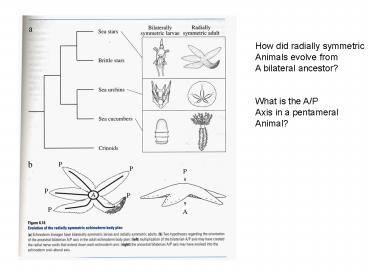How did radially symmetric - PowerPoint PPT Presentation
1 / 15
Title:
How did radially symmetric
Description:
1) Otx Arthropods/Chordates: Anterior CNS. Otx Urchin: Radial nerves ... Generally conserved in arthropods and chordates (A/P axis) ... – PowerPoint PPT presentation
Number of Views:35
Avg rating:3.0/5.0
Title: How did radially symmetric
1
How did radially symmetric Animals evolve from A
bilateral ancestor? What is the A/P Axis in a
pentameral Animal?
2
Question How can we use genes as Indicators of
Homologous structures? Are Urchins fundamentally
pentameral, or is this derived? What is the
echinoderm A/P axis? -Gene data cuts both ways
1) Otx Arthropods/Chordates Anterior CNS Otx
Urchin Radial nerves ____________________ Pentame
ral arms form A/P axis 2) Hox3 in teeth (oral),
Hox 11/13b in somatocoel (anal mesoderm) Hox
Arthropods/Chordates A/P axis -------------------
--------------- Bilateral Mouth to anus is A/P
axis 3) Hox 5b in spines ____________________ Spi
nes part of A/P axis
3
- Developmental genes, in particular HOX, are used
to identify - Ancient structures, because their expression and
function are - Generally conserved in arthropods and chordates
(A/P axis). - This conservation led to the inference that they
are in fact conserved because they - evolved from a shared, bilateral ancestor
(urbilateria), and their function is _____! - Thus, in a structure whose ancestral relationship
to urbilateria is - Unclear (sea urchin pentameral symmetry), these
genes can be used - To identify the ancestral relationship.
- But, what if the gene has been co-opted from A/P
axis to other use? - First premise such co-options shouldnt occur,
too fundamental to dispose of - Ancestral, axis-generating function
- 2) Second premise co-options do occur, not just
to late events (dll in eyespots), but - Even fundamental events (otx from gut to arms)
- 3) When do you say co-option vs. shared
ancestry? Its an argument, based
4
Take home -Same genes -Quite Different
Uses Question How can we use genes
as Indicators of Homologous structures?
IF the arms evolved From elaboration Of the
mouth, why Are the posterior Hox genes
expressed In the arms? If the funnel tube
evolved From the foot, why Does it
express Anterior hox genes?
5
Vertebrate novelties Notochord definitive of
chordates, co-option of brachyury from gut to
notochord Cranial placodes, thickened ectoderm
contributes to head structures (nose, eyes, ears,
lateral line), otic and olfactory placodes.
Found in basal chordates but elaborated in
vertebrates. Neural crest cells evolved at base
of vertebrate lineage. Generates neuronal And
other cell types. Migrate into brachial arches
to form cartilage and bone Of craniofacial
skeleton. Brachial arches elaboration of
gills, which first evolved in cephalochordate. For
m jaw, craniofacial skeleton. Paired appendages
fish fins, limbs.
6
Gut gene
7
Hemichordate Acorn worm stomochord
Urochordate Tunicate Larvae have Chordate
features, Lost in sessile adult
Cephalochordate - lancet
8
(No Transcript)
9
(No Transcript)
10
Neural crest cells migrate throughout the body
and differentiate into many different cell types.
Although neural crest cells are pluripotent,
differences exist between cells that are
generated from different anteroposterior levels
neural crest cells in the trunk form melanocytes
and several neuron and glia cell types, whereas
neural crest cells in the cranial (the embryonic
head region) also have the potential to form
mesenchymal derivatives, such as cartilage, bone
and connective tissue.
11
Hox expression in first Arch represses jaw
formation lamprey
12
Additional phase of Hox gene expression reversed
branching, reversed Hox expression
13
Simple changes can cause hindlimbs to reappear in
snakes, whales
14
(No Transcript)
15
(No Transcript)































